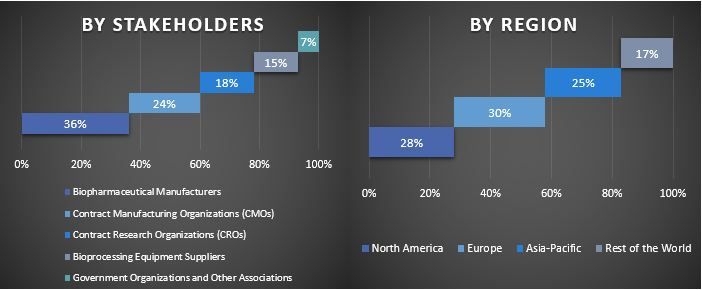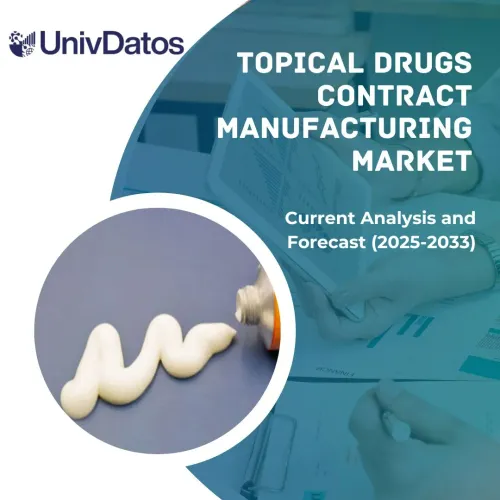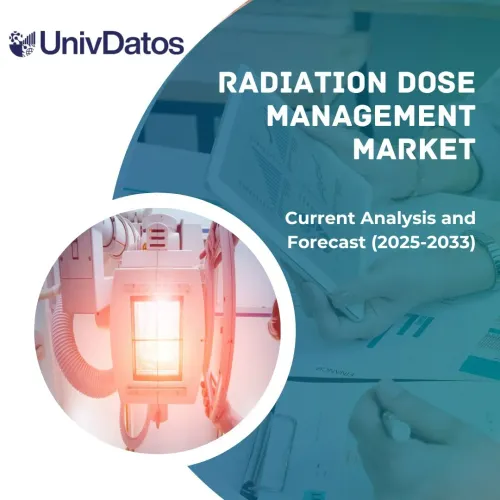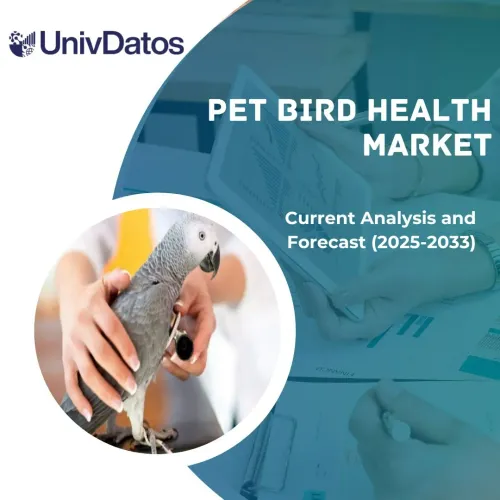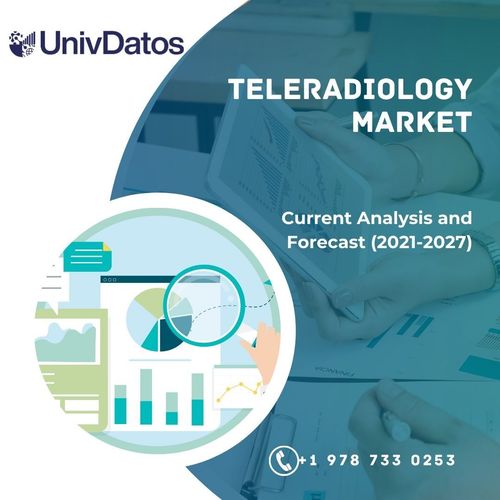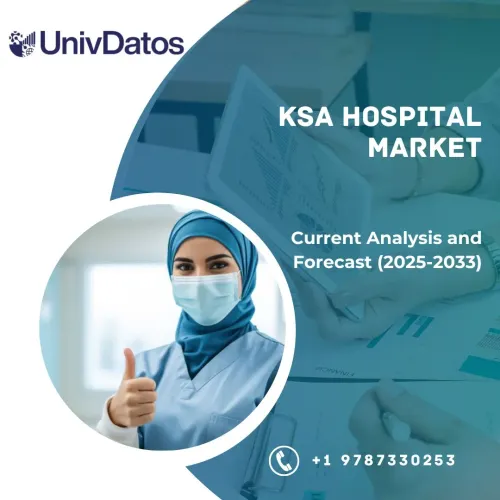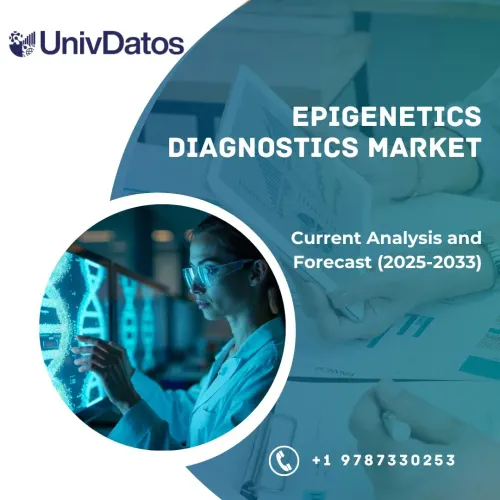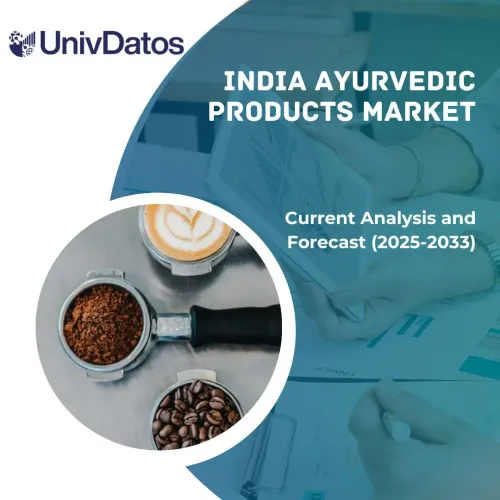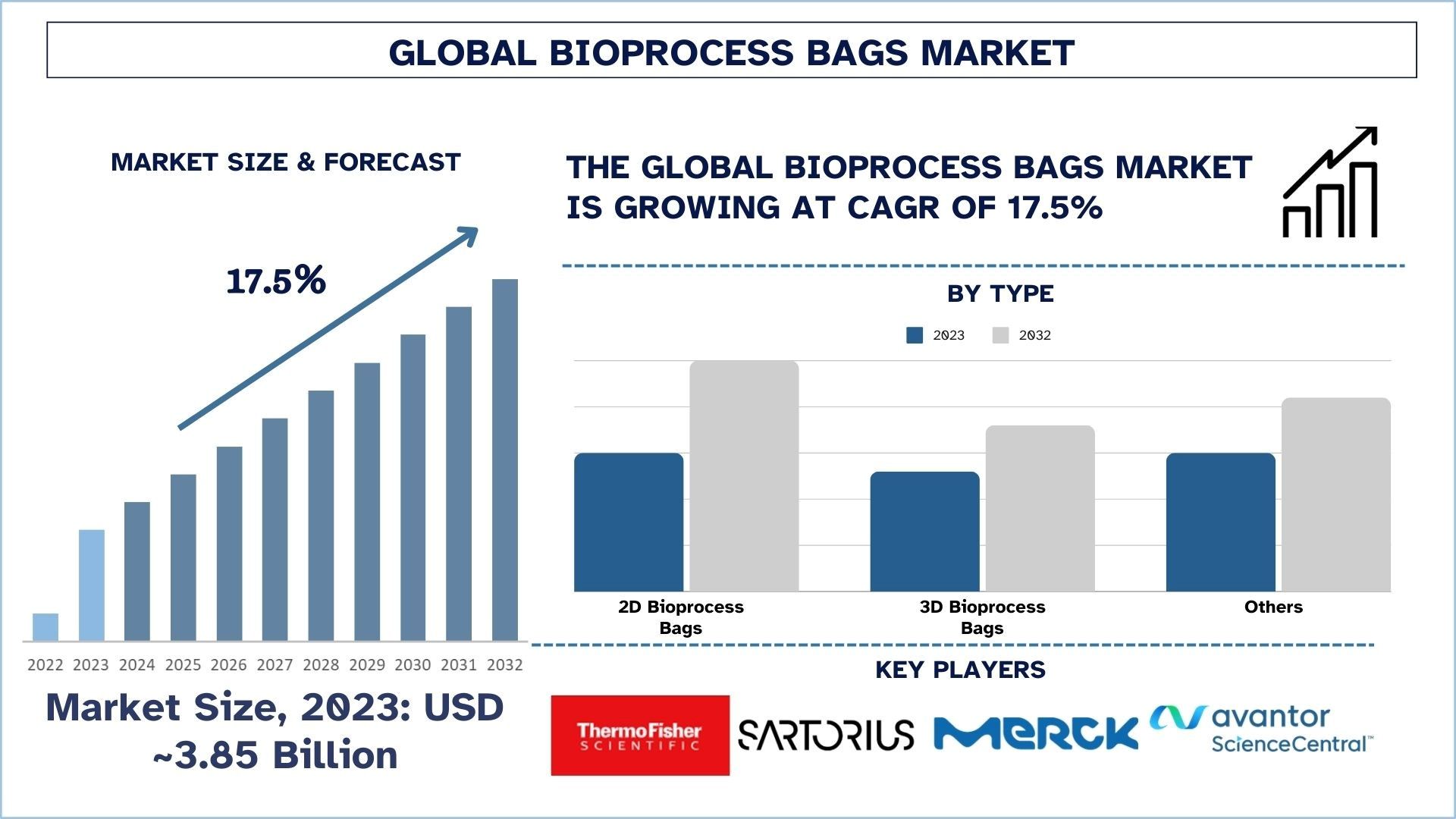
バイオプロセスバッグ市場規模と予測
バイオプロセスバッグ市場は、2023年には約38.5億米ドルと評価され、バイオ医薬品とバイオシミラーの需要増加により、予測期間(2024-2032年)に約17.5%の顕著なCAGRで成長すると予測されています。
バイオプロセスバッグ市場分析
バイオプロセスバッグは、したがって、主にバイオ医薬品プロセスにおける液体と培地の無菌貯蔵と輸送に使用される柔軟な単回使用バッグです。これらのバッグは高品質のポリマーフィルムでできており、アップストリーム、ダウンストリーム、および製剤エンドスキームで使用されます。その使用は汚染の可能性を排除し、ワークフローを容易にし、スケーラブルであるため、バイオ医薬品、ワクチン、および細胞治療に適しています。バイオプロセスバッグは、今日のシングルユースシステム技術を組み込んでおり、重要な業界における有効性と規制プロセスを改善します。
バイオプロセスバッグセクターを拡大するために、業界は、高強度で低溶出のフィルムを得るために材料の品質向上に集中しています。また、バイオ医薬品や遺伝子治療などの特定のアプリケーション市場向けに、ますます複雑さを増した製品ライン内で新製品を発売し続けています。自動化対応設計、リサイクル可能なバイオプロセスバッグ、およびそれぞれの業界における持続可能なソリューションの使用も需要を押し上げています。さらに、CMO/CROパートナーシップの増加と、発展途上市場における企業アウトレットの増加も、成長機会を強化します.
2023年4月24日 – 大手科学技術企業のMerckは、バイオプロセッシング液体用途に使用されるシングルユースアセンブリに極度の耐久性と耐漏洩性を提供するように設計されたUltimus®®シングルユースプロセスコンテナフィルムの発売を発表しました。
2023年8月17日、SartoriusとRepligen Corporationは、Repligen XCell®®ATFアップストリームインテンシフィケーション技術をSartoriusのBiostat STR®®バイオリアクターに統合した、バイオ医薬品メーカー向けのインテンシファイアードシードトレインとN灌流の実装を簡素化するバイオリアクターシステムの発売を発表しました。
バイオプロセスバッグ市場動向
このセクションでは、当社の調査専門家が特定した、バイオプロセスバッグ市場のさまざまなセグメントに影響を与える主要な市場動向について説明します。
2Dバイオプロセスバッグがバイオプロセスバッグ業界を変革
2Dバイオプロセスバッグは、2023年に市場の支配的なシェアを占めていました。これは、2Dバイオプロセスバッグのソリューションが、バイオ医薬品製造における経済的かつ省スペースの流体管理を通じて成長を促進するためです。これらは、培地、緩衝液、中間製品の保管と輸送に、完全な無菌性と柔軟性をもって使用するのに適しています。たとえば、2023年7月、医療およびバイオ医薬品業界向けのOEMシングルユースコンポーネントの世界的なサプライヤーであるQosinaは、半導体およびその他のハイテク製造業向けの高度な材料およびプロセスソリューションの主要サプライヤーであるEntegrisからのAramus 2Dバッグチャンバーの追加を発表しました。
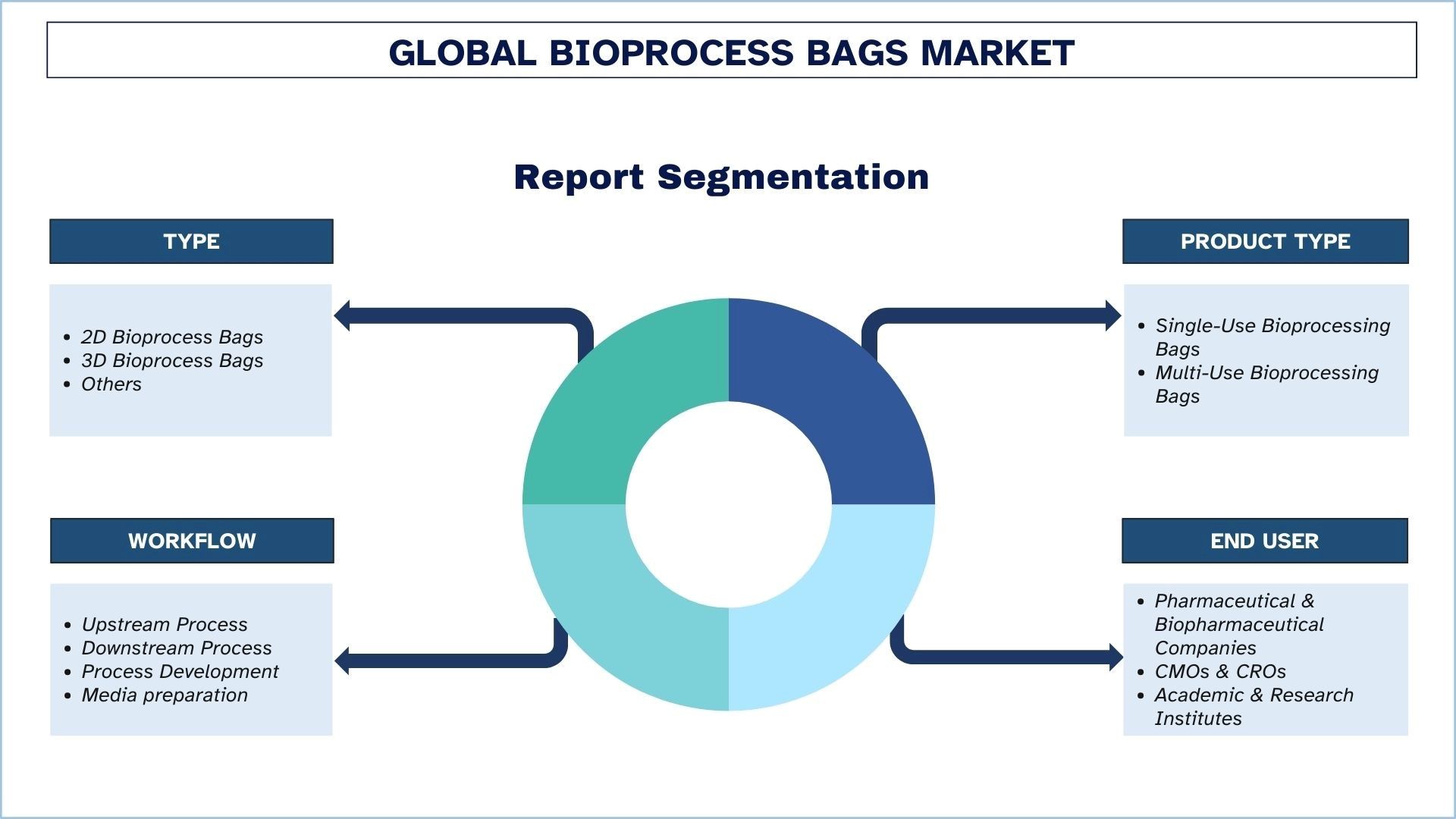
北米が市場をリードしています。
北米は、活況を呈するバイオ医薬品セクターと、バイオ医薬品とバイオシミラーの開発への注力により、バイオプロセスバッグ市場の成長に大きく貢献しています。これに加えて、アップストリームおよびダウンストリームプロセスのほとんどに対するシングルユース技術の採用が増加し、規模を拡大し、コストを大幅に削減するのに役立っています。バイオプロセスバッグは、北米の企業がモノクローナル抗体生産などのワクチンやその他の生物学的製剤、および最近では個別化医療を製造するために使用しています。さらに、戦略的パートナーシップ、研究開発投資、および地域協力によって採用が促進されています。
たとえば、2024年11月21日、バイオ医薬品業界の主要パートナーであるSartorius Stedim Biotechは、マサチューセッツ州マルボロに新しいバイオプロセスイノベーションセンターを開設しました。この最先端の施設は、Sartoriusの最新技術を実際のバイオプロセスワークフローに適用し、顧客やその他の外部イノベーションパートナーとのオンサイトでのコラボレーション、共同開発、学習を促進するように設計されています。
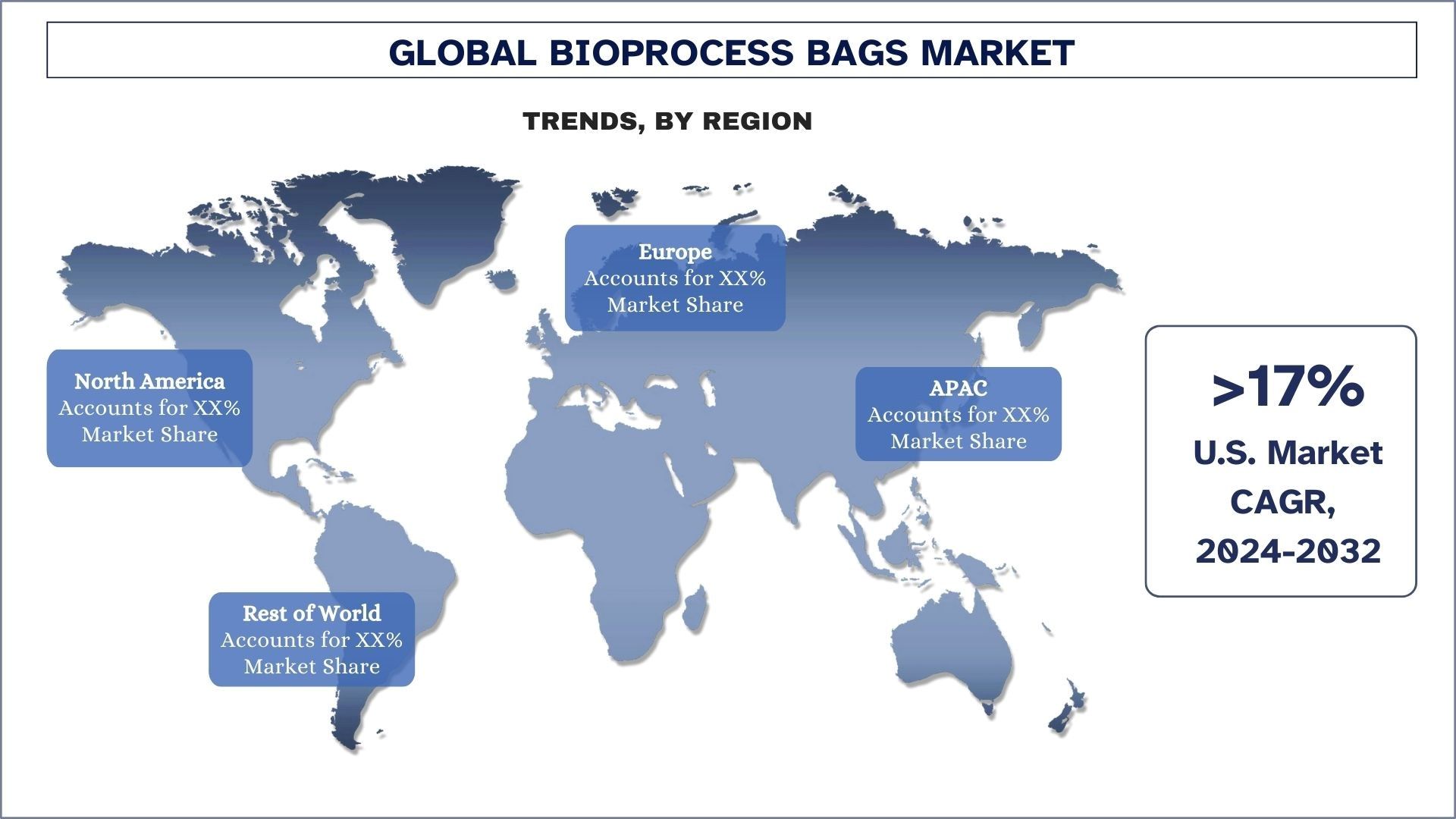
バイオプロセスバッグ市場概要
バイオプロセスバッグ市場は競争が激しく、いくつかのグローバルおよび国際的なプレーヤーが存在します。主要プレーヤーは、パートナーシップ、合意、コラボレーション、新製品の発売、地理的拡大、合併と買収など、市場プレゼンスを強化するためのさまざまな成長戦略を採用しています。市場で活動している主要プレーヤーには、Thermo Fisher Scientific Inc.; Sartorius AG; Merck KGaA; Saint-Gobain; Avantor, Inc.; Corning Incorporated; Lonza Group Ltd.; Entegris; Meissner Filtration Products, Inc.; Charter Medical (Solesis) などがあります。
バイオプロセスバッグ市場ニュース
たとえば、2024年7月 – Thermo Fisher Scientific TMOは、治療法の製造への気候影響を軽減し、バイオ医薬品治療法の開発の持続可能性を高めることができるバイオベースフィルムを発表しました。このユニークなソリューションは、顧客に広く使用され、検証されている同社の既存のAegisおよびCXフィルム製品に基づいています。
2023年7月、医療およびバイオ医薬品業界向けのOEMシングルユースコンポーネントの世界的なサプライヤーであるQosinaは、半導体およびその他のハイテク製造業向けの高度な材料およびプロセスソリューションの主要サプライヤーであるEntegrisからのAramus 2Dバッグチャンバーの追加を発表しました。
2022年10月、オーストリアのソリューションプロバイダーであるSingle Use Support GmbHは、IRISというブランド名で新しいシングルユースバイオプロセスコンテナで製品ポートフォリオを拡大しました。この先駆的な会社は、バイオ医薬品流体管理分野で信頼性の高いプロセスソリューションを提供するためにノウハウを活用し、ベンダーに依存しないアプローチを追求し続けています。
バイオプロセスバッグ市場レポートの範囲
レポートの属性 | 詳細 |
基準年 | 2023 |
予測期間 | 2024-2032 |
成長の勢い | 17.5%のCAGRで加速 |
市場規模2023 | USD 3.8500億 |
地域分析 | 北米、ヨーロッパ、アジア太平洋、世界 |
主要貢献地域 | アジア太平洋地域は、予測期間中に最も高いCAGRで成長すると予想されます。 |
対象となる主要国 | 米国、カナダ、ドイツ、フランス、英国、スペイン、イタリア、中国、日本、インド |
プロファイルされた企業 | Thermo Fisher Scientific Inc.; Sartorius AG; Merck KGaA; Saint-Gobain; Avantor, Inc.; Corning Incorporated; Lonza Group Ltd.; Entegris; Meissner Filtration Products, Inc.; Charter Medical (Solesis). |
レポートスコープ | 市場動向、推進要因、抑制要因; 収益推定と予測; セグメンテーション分析; 需要と供給側の分析; 競争環境; 企業プロファイリング |
対象セグメント | 別タイプ別、製品タイプ別、ワークフロー別、エンドユーザー別、地域/国別 |
本レポートを購入する理由:
本調査には、認証された主要な業界専門家によって検証された、市場規模と予測分析が含まれています。
本レポートは、業界全体のパフォーマンスをひとめで確認できる概要を提供します。
本レポートは、主要な財務、製品ポートフォリオ、拡張戦略、および最近の動向に焦点を当て、主要な業界関係者の詳細な分析をカバーしています。
業界で蔓延する推進要因、抑制要因、主要なトレンド、および機会の詳細な調査。
本調査は、さまざまなセグメントにわたる市場を包括的にカバーしています。
業界の詳細な地域レベル分析。
カスタマイズオプション:
世界のバイオプロセスバッグ市場は、要件または他の市場セグメントごとにさらにカスタマイズできます。 これらに加えて、UMIは、お客様独自のビジネスニーズがある可能性があることを理解しています。 したがって、お客様の要件に完全に合ったレポートを入手するために、お気軽にお問い合わせください。
目次
バイオプロセスバッグ市場分析(2022-2032)の研究方法
過去の市場の分析、現在の市場の推定、および世界のバイオプロセスバッグ市場の将来の市場の予測は、世界中の主要地域でのバイオプロセスバッグの採用を作成および分析するために実行された3つの主要なステップでした。 過去の市場規模を収集し、現在の市場規模を推定するために、徹底的な二次調査が実施されました。 第二に、これらの洞察を検証するために、数多くの調査結果と仮定が考慮されました。 さらに、世界のバイオプロセスバッグ市場のバリューチェーン全体にわたる業界専門家との徹底的な一次インタビューも実施されました。 一次インタビューによる市場規模の仮定と検証の後、トップダウン/ボトムアップアプローチを採用して、完全な市場規模を予測しました。 その後、市場の細分化とデータの三角測量手法を採用して、業界のセグメントとサブセグメントの市場規模を推定および分析しました。 詳細な方法論は以下に説明されています:
過去の市場規模の分析
ステップ1:二次資料の詳細な調査:
年次報告書と財務諸表、パフォーマンスプレゼンテーション、プレスリリースなどの企業内部資料、ジャーナル、ニュースと記事、政府刊行物、競合他社の刊行物、セクターレポート、サードパーティデータベース、その他の信頼できる刊行物を含む外部資料を通じて、バイオプロセスバッグ市場の過去の市場規模を取得するために、詳細な二次調査が実施されました。
ステップ2:市場セグメンテーション:
バイオプロセスバッグ市場の過去の市場規模を取得した後、主要地域のさまざまなセグメントとサブセグメントの過去の市場洞察とシェアを収集するために、詳細な二次分析を実施しました。 主要セグメントには、タイプ、製品タイプ、ワークフロー、エンドユーザー、および地域が含まれています。 さらに、国レベルの分析を実施して、その地域でのテストモデルの全体的な採用を評価しました。
ステップ3:要因分析:
さまざまなセグメントとサブセグメントの過去の市場規模を取得した後、バイオプロセスバッグ市場の現在の市場規模を推定するために、詳細な要因分析を実施しました。 さらに、バイオプロセスバッグ市場のタイプ、製品タイプ、ワークフロー、エンドユーザー、および地域などの従属変数と独立変数を使用して、要因分析を実施しました。 世界中のバイオプロセスバッグ市場セクターにおける主要なパートナーシップ、合併と買収、事業拡大、および製品発売を考慮して、需要と供給側のシナリオについて徹底的な分析が実施されました。
現在の市場規模の推定と予測
現在の市場規模のサイジング:上記の3つのステップからの実行可能な洞察に基づいて、現在の市場規模、世界のバイオプロセスバッグ市場の主要プレーヤー、およびセグメントの市場シェアに到達しました。 上記の二次アプローチを使用して、必要なすべてのパーセンテージシェア分割と市場の内訳が決定され、一次インタビューを通じて検証されました。
推定と予測:市場の推定と予測のために、推進要因とトレンド、抑制要因、およびステークホルダーが利用できる機会を含むさまざまな要因に重みが割り当てられました。 これらの要因を分析した後、関連する予測手法、つまり、トップダウン/ボトムアップアプローチを適用して、世界中の主要市場のさまざまなセグメントとサブセグメントについて2032年の市場予測に到達しました。 市場規模を推定するために採用された調査方法には以下が含まれます:
主要市場におけるバイオプロセスバッグ市場の収益(米ドル)の観点からの業界の市場規模と採用率
市場セグメントとサブセグメントのすべてのパーセンテージシェア、分割、および内訳
提供される製品の観点からの世界のバイオプロセスバッグ市場の主要プレーヤー。 また、急速に成長する市場で競争するためにこれらのプレーヤーが採用している成長戦略
市場規模とシェアの検証
一次調査:主要地域全体のトップレベルエグゼクティブ(CXO/VP、販売責任者、マーケティング責任者、運用責任者、地域責任者、カントリーヘッドなど)を含む主要なオピニオンリーダー(KOL)との詳細なインタビューが実施されました。 次に、一次調査の結果が要約され、統計分析が実行されて、述べられた仮説が証明されました。 一次調査からの入力は二次的な調査結果と統合され、情報を実行可能な洞察に変換しました。
さまざまな地域における一次参加者の内訳
市場エンジニアリング
データの三角測量手法を採用して、全体的な市場推定を完了し、世界のバイオプロセスバッグ市場の各セグメントとサブセグメントについて正確な統計数に到達しました。 データの細分化は、世界のバイオプロセスバッグ市場のタイプ、製品タイプ、ワークフロー、エンドユーザー、および地域のさまざまなパラメーターとトレンドを調査した後、いくつかのセグメントとサブセグメントに分割されました。
世界のバイオプロセスバッグ市場調査の主な目的
世界のバイオプロセスバッグ市場の現在のおよび将来の市場動向が本調査で特定されました。 投資家は、本調査で実施された定性的および定量的分析に基づいて、投資に関する裁量を決定するための戦略的洞察を得ることができます。 現在および将来の市場動向は、地域レベルでの市場全体の魅力を決定し、業界参加者が未開拓市場を活用して、ファーストムーバーの優位性から利益を得るためのプラットフォームを提供しました。 調査のその他の定量的目標には以下が含まれます:
バイオプロセスバッグ市場の現在の市場規模と予測市場規模を価値(米ドル)で分析します。 また、さまざまなセグメントとサブセグメントの現在の市場規模と予測市場規模を分析します。
調査のセグメントには、タイプ、製品タイプ、ワークフロー、エンドユーザー、および地域が含まれます。
バイオプロセスバッグの規制枠組みを定義および分析する
さまざまな仲介業者の存在に関連するバリューチェーンを分析し、業界の顧客と競合他社の行動を分析する。
主要地域のバイオプロセスバッグ市場の現在の市場規模と予測市場規模を分析する。
本レポートで調査された主要な地域の国には、アジア太平洋、ヨーロッパ、北米、および世界のその他の地域が含まれます
バイオプロセスバッグ市場の企業プロファイルと、急速に成長する市場を維持するために市場プレーヤーが採用している成長戦略。
業界の地域レベルの詳細分析
よくある質問 よくある質問
Q1:バイオプロセスバッグ市場の現在の規模と成長の可能性は?
バイオプロセスバッグ市場は2023年に38.5億米ドルと評価され、予測期間(2024~2032年)中に年平均成長率17.5%で成長すると予想されています。
Q2:バイオプロセスバッグ市場の成長を促進する要因は何ですか?
バイオ医薬品の生産の増加、ワクチンの生産の増加、バイオテクノロジー業界の世界的な拡大、技術的進歩、規制による支援の増加が、バイオプロセスバッグ市場を牽引しています。
Q3:タイプ別のバイオプロセスバッグ市場で最も大きなシェアを占めているセグメントは?
2Dバイオプロセスバッグが、タイプ別のバイオプロセスバッグ市場で最大のシェアを占めています。
Q4:バイオプロセスバッグ市場の主要なトレンドは何ですか?
使い捨ておよびシングルユースシステムへの移行と、個別化医療の成長が、バイオプロセスバッグ市場の主要なトレンドです。
Q5:どの地域がバイオプロセスバッグ市場を支配するのでしょうか?
北米が2023年に市場を支配しました。
関連 レポート
この商品を購入したお客様はこれも購入しました

